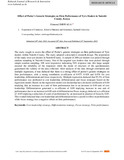Effect of Porter’s Generic Strategies on Firm Performance of Tyre Dealers in Nairobi County, Kenya
Abstract
The study sought to assess the effect of Porter’s generic strategies on firm performance of Tyre
dealers within Nairobi County. The study adopted a descriptive research design. The population
of the study were tyre dealers in Nairobi County. A sample of 200 tyre dealers was picked through
random sampling in Nairobi County. Out of the targeted tyre dealers that were picked through
simple random sampling, 108 were responsive indicating 54% response rate, this large sample
ensured the reliability of the responses while the mode of structure of the questionnaires
guaranteed the validity of the data collected. After analysis of the data through correlation and
multiple regression, it was deduced that there is a strong effect of porter’s generic strategies on
firm performance, with a strong correlation co-efficient of 0.975, 0.928 and 0.976 for cost
leadership, differentiation and focus respectively. Multiple regression deduced that 95.2% of firm
performance was attributed to cost leadership, differentiation and focus strategies based on the
regression model. Based on the regression model cost leadership has a deduced coefficient of 0.84
implying that an increase in a unit of firm performance due to an increase in 0.84 unit of cost
leadership. Differentiation generated a co-efficient of 0.09 implying increase in one unit of
performance due to an increase in 0.09 unit of differentiation Focus strategy deduced a co-efficient
of -0.05 implying a reduction of a unit of performance by an increased in practice of focus by 0.05.
This overall indicated that cost leadership and differentiation have a positive effect on performance
while focus strategy has a negative effect on firm performance.

